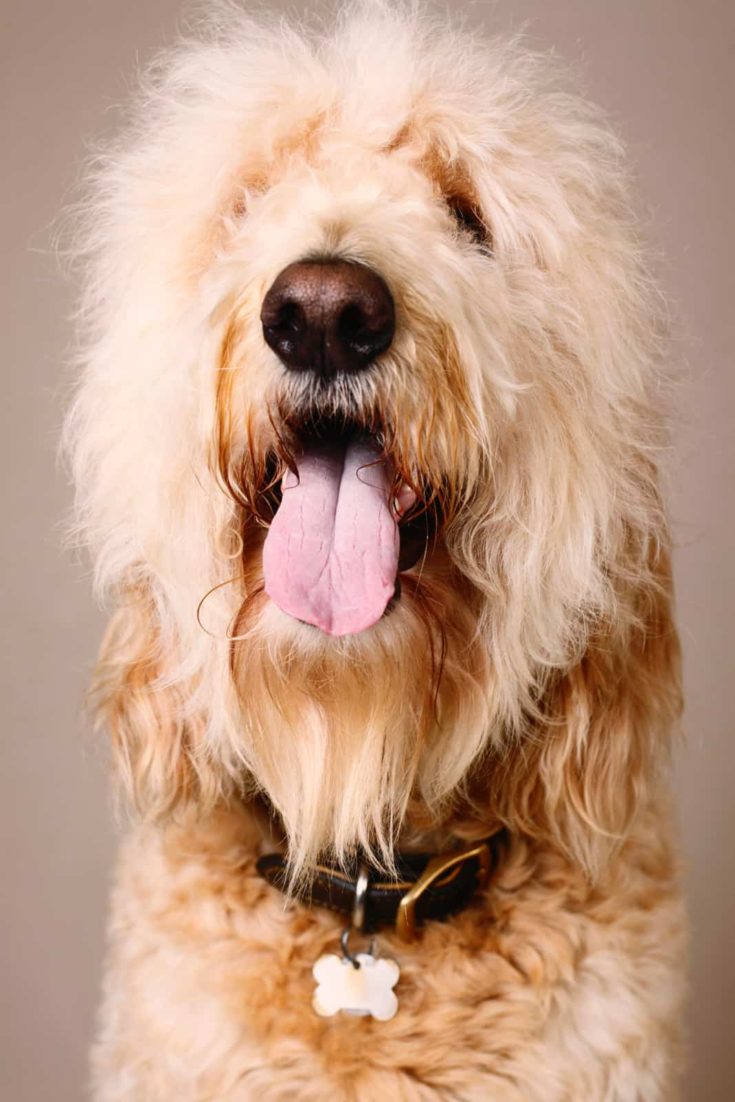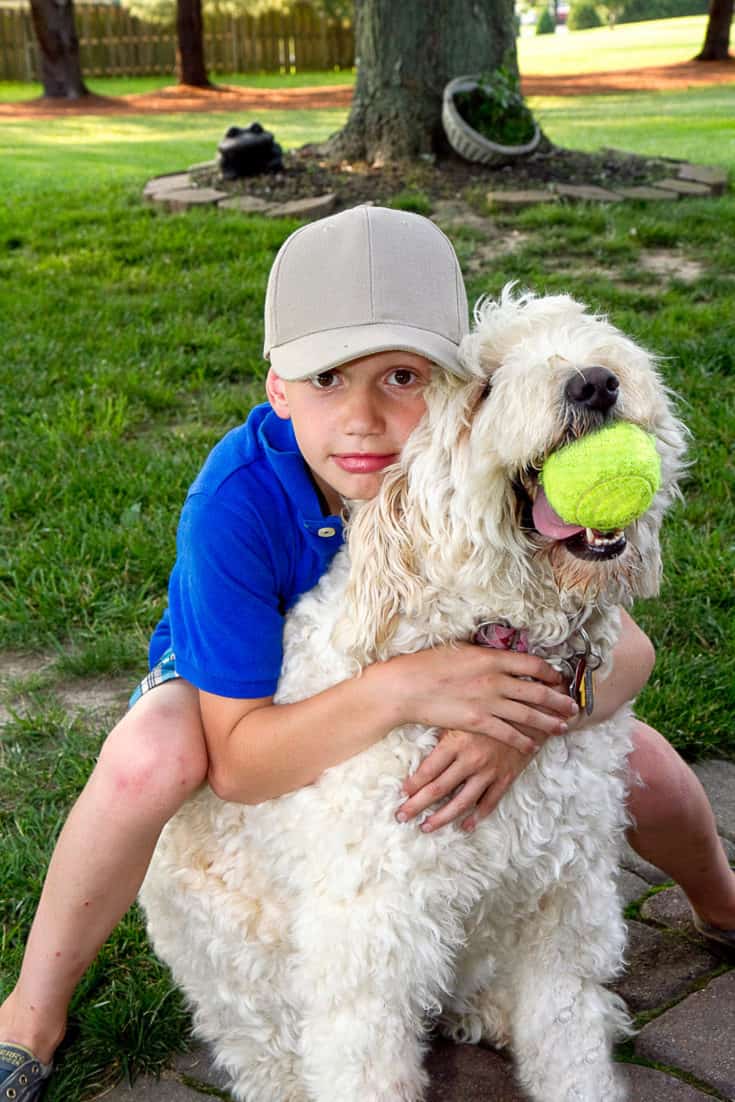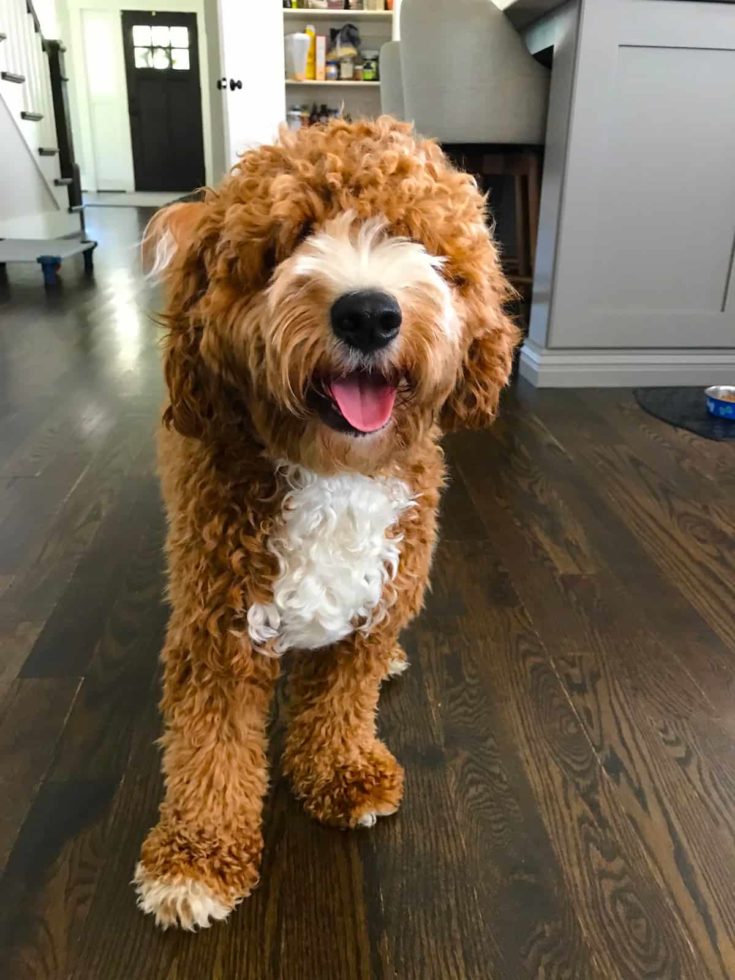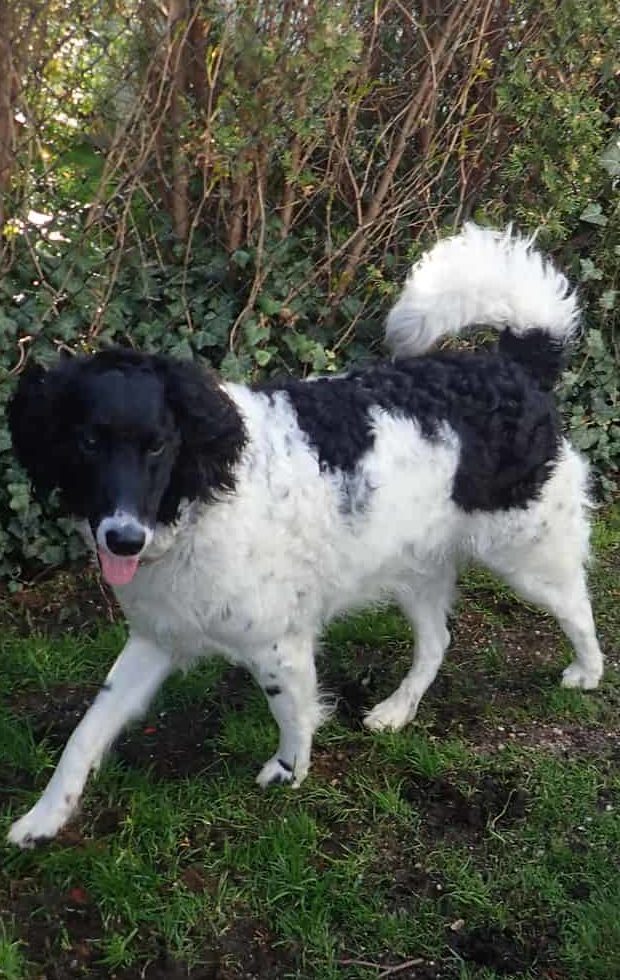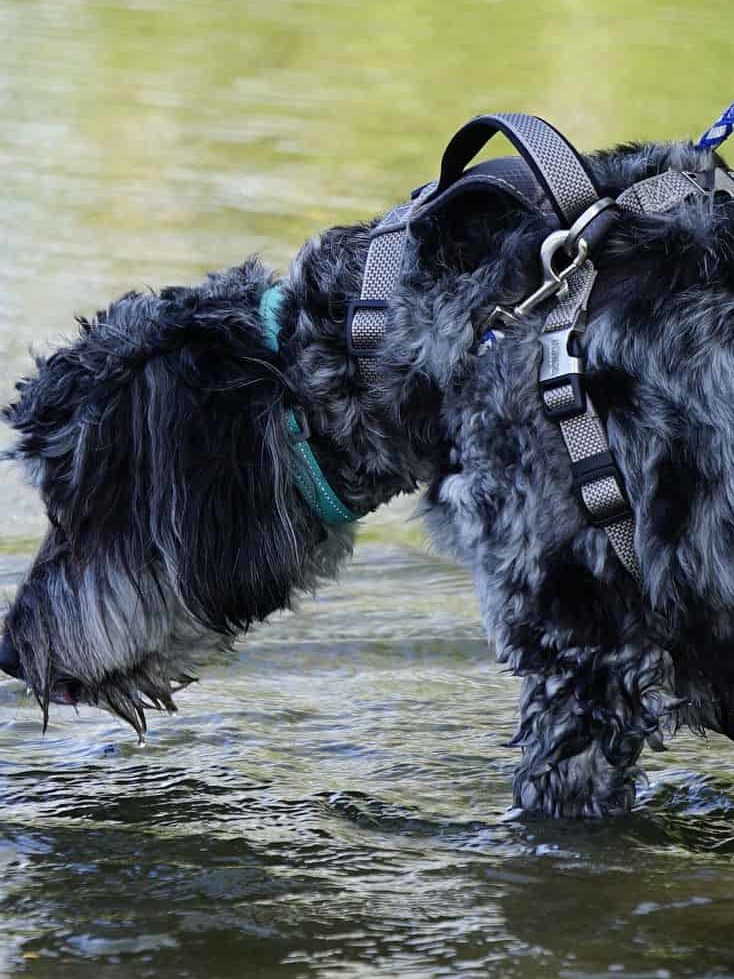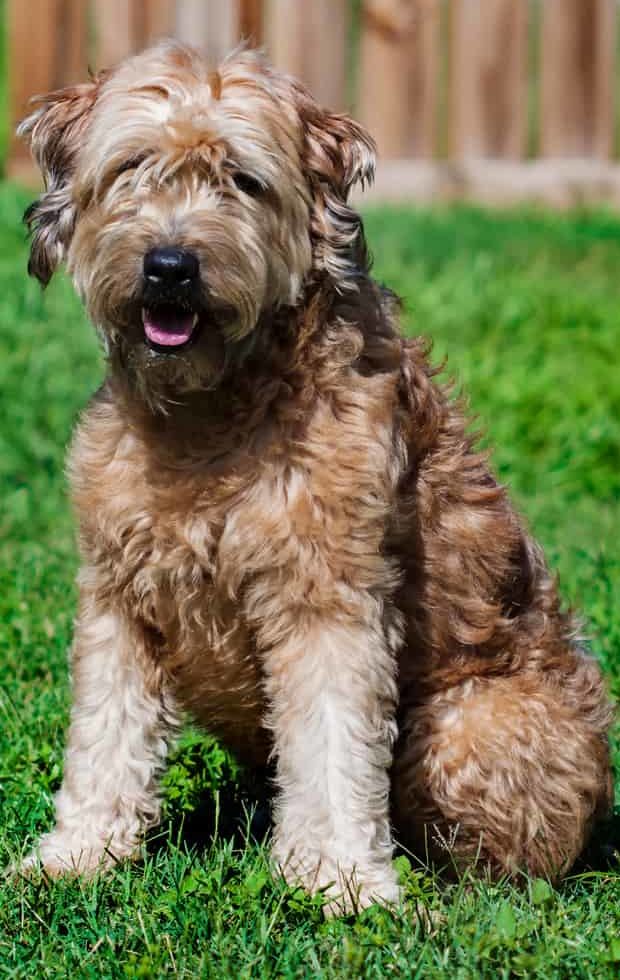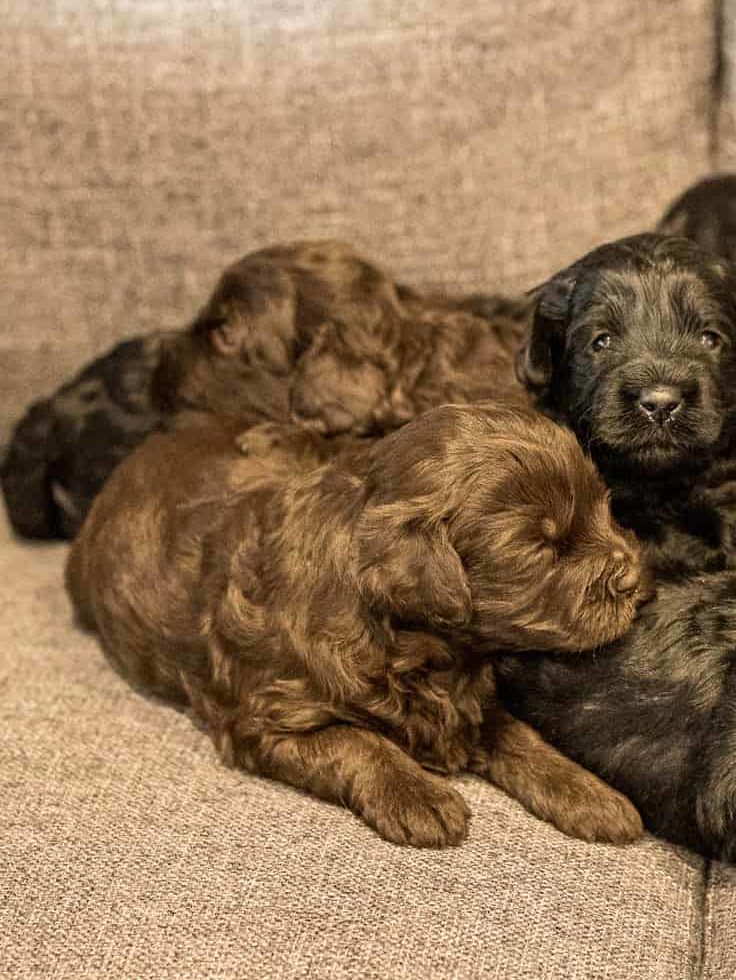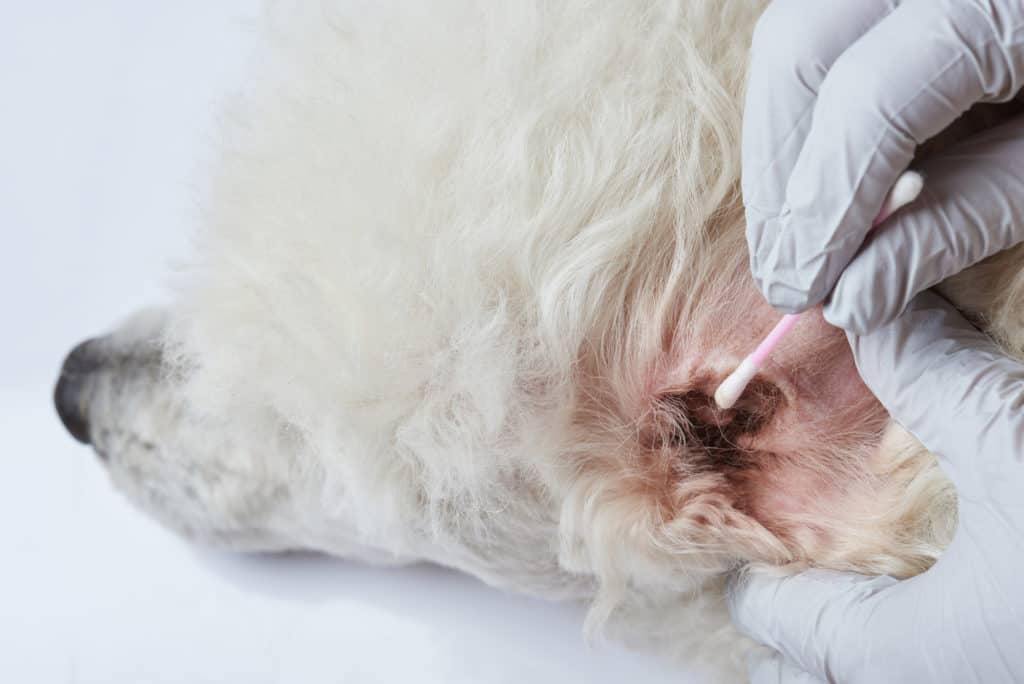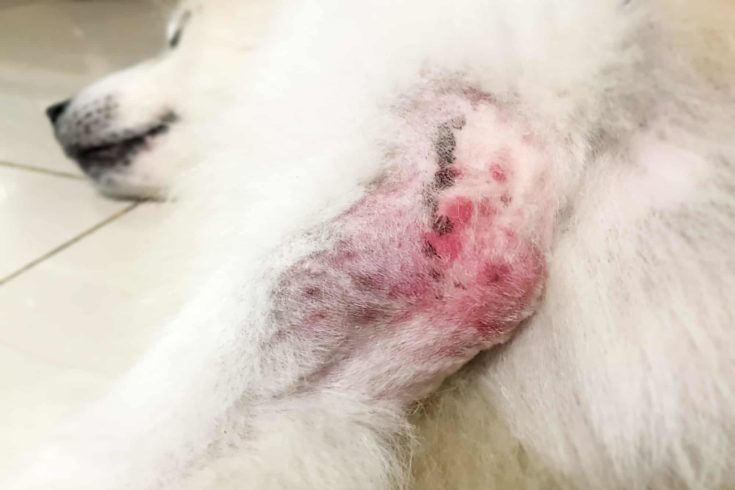Complete Guide to Goldendoodles: Colors, Sizes, Health Tips and More!
ซีรีส์ที่ถูกเก็บถาวร ("ฟีดที่ไม่ได้ใช้งาน" status)
When?
This feed was archived on August 02, 2022 14:27 (
Why? ฟีดที่ไม่ได้ใช้งาน status. เซิร์ฟเวอร์ของเราไม่สามารถดึงฟีดพอดคาสท์ที่ใช้งานได้สักระยะหนึ่ง
What now? You might be able to find a more up-to-date version using the search function. This series will no longer be checked for updates. If you believe this to be in error, please check if the publisher's feed link below is valid and contact support to request the feed be restored or if you have any other concerns about this.
Manage episode 290656434 series 2915666
It’s safe to say that the craze for poodle mixes, or “doodles,” is more than a passing fad. One of the most popular options for families and first-time dog owners is the loveable, intelligent and good-natured golden retriever/poodle mix, affectionately known as the Goldendoodle. Let’s take an in-depth look at this “designer” breed!
Overview of the Goldendoodle
Poodles and golden retrievers have long been two of the most popular breeds in the US, but there wasn’t much interest in their crossbred Goldendoodle offspring until recently. According to the website Rover.com, mixed breed dogs like the Goldendoodle were the #1 most popular choice for dog owners in 2020!
Why is there such a demand for these fluffy mixed-breed puppies now, and what do you need to know before adopting a Goldendoodle? In this complete guide, we’ll breakdown their typical personality and appearance, and offer tips on diet and feeding, training, grooming and common health concerns in Goldendoodles.
Goldendoodle Breed Group:
Mixed Breed
Poodle & Golden Retriever cross
Average Weight:
20 to 50pounds
Average Height:
14 – 17 inches
Preferred Coat Texture & Length:
Curly or wavy: 2 to 3 inches in length
Coat Colors:
Cream, apricot, red, chocolate and black
Life Expectancy:
10 to 15 years
Brief History of Goldendoodles
You might think of Goldendoodles as a new breed, but they’ve been around in small numbers since at least the 1960s. It wasn’t until the doodle dog trend took hold in the early 2000s, and intentionally-bred mutts were rebranded as “designer dogs,” that the Goldendoodle became the household name they are today.
The original goal for breeders was to produce friendly and smart “hypoallergenic” service animals and pets for people with allergies. These standard poodle & golden mixes were consistently good-natured and outgoing, and their frankly adorable appearance proved highly popular and brought even more breeders into the trade.
Demand for smaller versions with the same fun-loving personality and cuteness factor as the standard cross led breeders to create new lines from toy, mini and medium-sized poodles. Today, lovable Goldendoodles are available from breeders across the country in a range of sizes, colors and patterns.
Appearance and Size: What do Goldendoodles Look Like?
Goldendoodles are not recognized as a breed by the American Kennel Club or other purebred canine organizations, and there’s no widely accepted standards for what a Goldendoodle should look like. Dogs from different breeders may vary a great deal in their shape, size and coat characteristics. So what can you expect from yours?
- In general, full-grown adult Goldendoodles tend to favor the poodle in shape and conformation and usually have a narrower, deeper chest than a golden
- Their long fur lends them a rakishly messy and careless appearance that can resemble a sheepdog, although the poodle can really stand out after a haircut
- Goldendoodle puppies are so cute and huggable they’re like living teddy bears, with big brown eyes, adorable fuzzy faces and their all-around exuberant and affectionate natures
Goldendoodle Size Ranges: Average Weight and Height
How big do Goldendoodles get? While not all breeders agree, the Goldendoodle Association of North America recognizes 4 sizes of Goldendoodle. Your dog’s size will depend in part on which type of poodle(s) and which generation they descend from, and you can see these broad weight and height ranges in the table below.
Goldendoodle Sizes
Petite
Miniature
Medium
Standard
Weight Range
25 pounds or less
26 to 35 pounds
36 to 50 pounds
36 to 50 pounds
Height Range
14 inches and under
14 to 17 inches
17 to 21 inches
21 inches and up
Goldendoodle Sizes
Petite
Weight Range
25 pounds or less
Height Range
14 inches and under
Goldendoodle Sizes
Miniature
Weight Range
26 to 35 pounds
Height Range
14 to 17 inches
Goldendoodle Sizes
Medium
Weight Range
36 to 50 pounds
Height Range
17 to 21 inches
Goldendoodle Sizes
Standard
Weight Range
50 to 90 pounds
Height Range
21 inches and up
Coat Colors and Patterns in Goldendoodles
Goldendoodles come in a variety of colors, but most range from a pale blonde to deep red, since the genes for cream, apricot and red coats are carried by both poodles and goldens. But poodles also carry genes for brown, black and grey coats and several interesting patterns like phantom and brindle.
Your dog’s colors can play a role in their overall health since some coat patterns are linked genetically to problems with their skin, vision and hearing. Merle colored Goldendoodles, for instance, are often born blind and deaf, and even healthy merle puppies may develop problems with their eyesight, hearing and skin/coat.
Goldendoodle Coat Colors
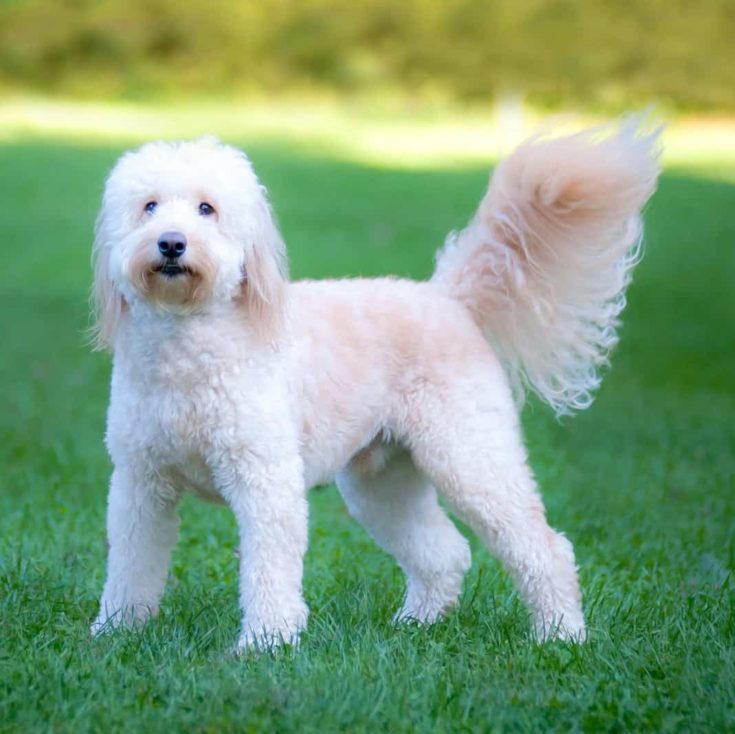
Cream

Apricot
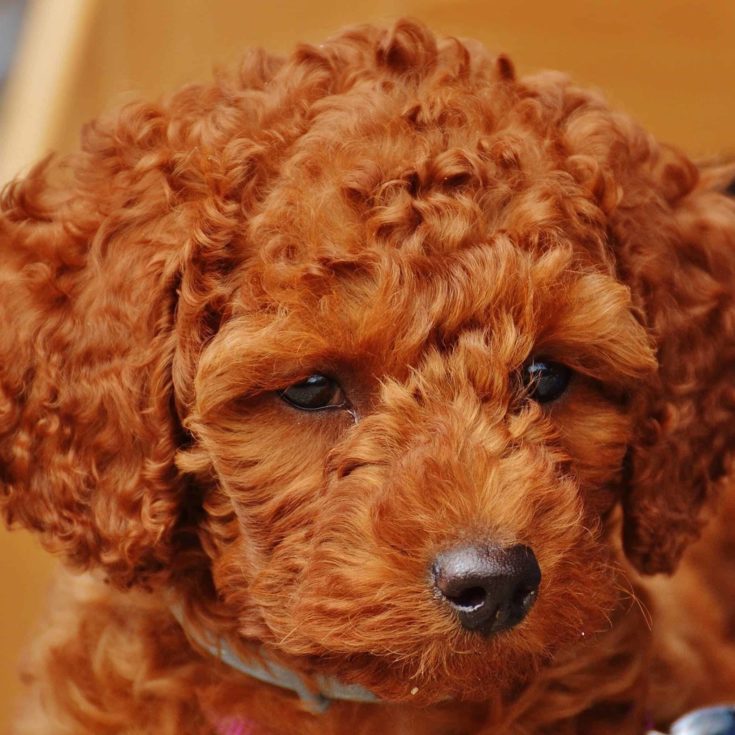
Red

Chocolate

Black
Fur Texture and Length, Facial Hair and Shedding
The coat length and texture of Goldendoodle fur also varies widely, since they can be born with a poodle-like curly coat, a wavy in-between type or come with straight golden retriever fur. Straight fur is usually the least desirable in doodles, but since it’s controlled by a recessive gene it often shows up in later generations.
- Unlike Labradoodles, which can have long or short fur, Goldendoodles are always long-haired, but the actual length may vary quite a bit
- 2 to 3 inches is the preferred length, but I’ve seen Goldendoodles that looked like fluffy sheep, with fur sticking out in all directions and longer than 6 inches
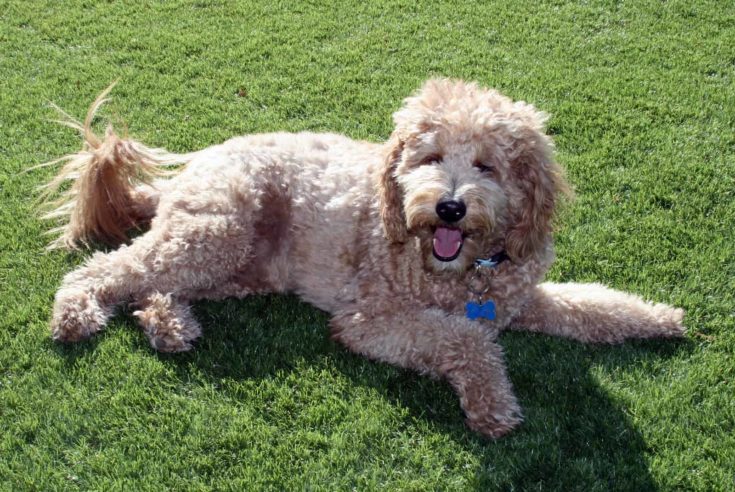
Shedding is controlled by at least two genes that we know of, so breeders can test their stock and predict pretty accurately the chances of producing high-shedding vs low-shedding puppies for any particular mating. But shedding is also associated with other characteristics, like facial hair:
- Poodles (and many Goldendoodles) have what’s called a “furnished” face or a “correct” coat, which means they have long, furry eyebrows, mustaches and beards
- Golden retrievers have an “open face” covered with short fur (also termed an “incorrect coat”), and Goldendoodles with this trait look more golden-like and shed more than the “furnished” varieties
- All dogs shed at least a little if they have fur, so there’s no such thing as a completely non-shedding breed, just hairless and low-shedding dogs. Puppies from matings with a low shedding index may still trigger allergies, but they’re less likely to be problematic than “open-faced” or “incorrect” doodles
Goldendoodle Fur Texture
Curly, Wavy, Straight (less desirable to some)
Shedding Potential
Low-shedding Sheds freely (not desirable)
Facial Hair (Furnishings)
Long, Short or Open(not usually desirable)
Generational Effects on Appearance and Health
With such a wide variety of traits, Goldendoodles can be all over the map in terms of their look and how much they shed. Which generation of doodle you adopt also influences their appearance and even their potential health, as you can see in the examples outlined in the table below:
- Goldendoodles are mixed breed and still under development, and the breed is not yet genetically stable (doesn’t “breed true”).
- Indiscriminately breeding Goldendoodles to Goldendoodles without crossing back to the poodle results in a higher percentage of puppies with undesirable traits like straight, shedding fur and an “open” face.
- If you’re just looking for an adorable pet, your puppy’s generation probably won’t matter very much.
- If you plan on breeding your adult dog, prefer a specific texture of coat, or need a low-shedding doodle for an allergy sufferer, then you’ll want to work closely with your breeder to select the ideal generation for your needs.
Goldendoodle Generation
F1
F1B
Multigen
Parent Combo
Golden retriever & poodle
F1 Goldendoodle & poodle
F1B Goldendoodle & either F1 or F1B Goldendoodle or poodle
Generational Trends
– Offspring 50% poodle & 50% golden
– Appearance and personality vary widely
– Shedding and coat texture unpredictable
– Often larger than either parent, and less likely to suffer from common health problems (see Hybrid Vigor below)
– Offspring 75% poodle & 25% golden
– Appearance and personality are usually more uniform
– More likely to have low-shedding curly or wavy coat
– May be slightly larger and develop fewer health issues than parents, but less likely to benefit from hybrid vigor than F1-generation
– Percentages of poodle/golden will vary depending on the specific cross, but often bred back to poodle lines to eliminate undesired traits (straight coat/shedding)
– Likely to have curly, low-shed coat
– Unlikely to show any increased health or size benefits, as they’re mostly (~80%) poodle
Goldendoodle Generation
F1
Parent Combo
Golden retriever & poodle
Generational Trends
– Offspring 50% poodle & 50% golden
– Appearance and personality vary widely
– Shedding and coat texture unpredictable
– Often larger than either parent, and less likely to suffer from common health problems (see Hybrid Vigor below)
Goldendoodle Generation
F1B
Parent Combo
F1 Goldendoodle & poodle
Generational Trends
– Offspring 75% poodle & 25% golden
– Appearance and personality are usually more uniform
– More likely to have low-shedding curly or wavy coat
– May be slightly larger and develop fewer health issues than parents, but less likely to benefit from hybrid vigor than F1-generation
Goldendoodle Generation
Multigen
Parent Combo
F1B Goldendoodle & either F1 or F1B Goldendoodle or poodle
Generational Trends
– Percentages of poodle/golden will vary depending on the specific cross, but often bred back to poodle lines to eliminate undesired traits (straight coat/shedding)
– Likely to have curly, low-shed coat
– Unlikely to show any increased health or size benefits, as they’re mostly (~80%) poodle
Goldendoodle Personality and Behavior
Goldendoodle breeders focus a lot of attention on the personality and behavioral characteristics of their dogs, while also striving to produce healthy puppies with a marketable appearance. It’s critical that aggressive or unfriendly animals are eliminated from a line, just like those with health or conformation problems.
Ideally, Goldendoodles exhibit the best personality traits from each parent breed, and should have the intelligence of a poodle along with the trainability and affable temperament of goldens. As one breeder put it to me a few years ago, they aim to temper some of the silliness of the golden with the practical poodle’s common sense:
- Goldendoodles should have a friendly, outgoing personality and a strong desire to please, just like their golden retriever ancestors.
- They’re usually very easy to train and are less sensitive to correction than poodles, although like them, they still benefit from positive rather than negative reinforcement.
- Personality and behavioral traits may also vary depending on the type of poodle(s) they descend from, since there’s noticeable differences between the smaller and standard poodle breeds.
Living With a Goldendoodle
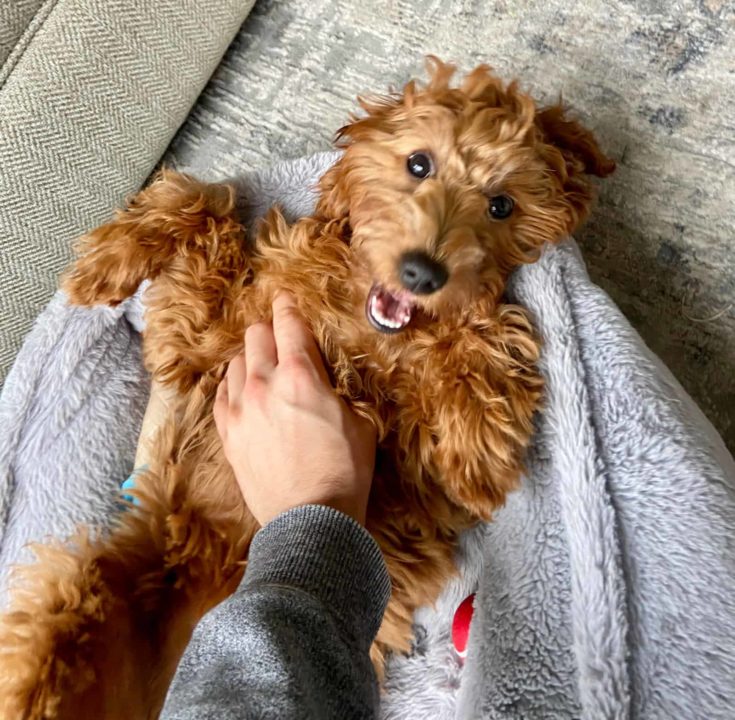
Goldendoodles bond closely with their families and enjoy being around people, so they don’t do well as outdoor dogs and they don’t enjoy spending a lot of time alone. These social and intelligent companions thrive on attention and need regular physical and mental stimulation:
- Goldendoodles are high-energy dogs who require daily exercise, although it doesn’t need to be an intense activity.
- These smart dogs are easily bored, though, so use short training sessions and/or food puzzle games to wear them out mentally.
- While some doodles are noisier than others, they’re not usually barkers and are too friendly to function as much of a guard dog, so they aren’t a good choice if you need a security hound.
Typical Behavioral Problems in Goldendoodles
Goldendoodles have proven themselves to be a smart, devoted, and downright charming companion that’s ideal for new and first-time dog owners and especially for families with children. But for all their positive traits, their personality mix can also lead to problems if their energy isn’t channeled:
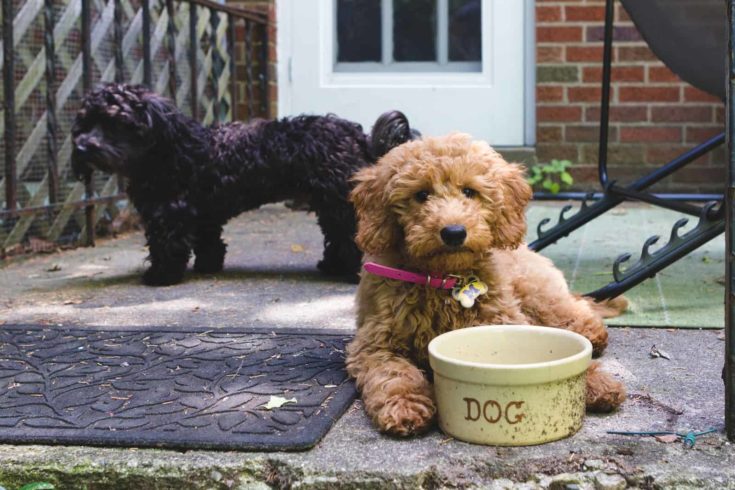
- Goldendoodles have a tendency to develop separation anxiety around 6 months of age, which means they may act out when left by themselves.
- Like the golden retriever, doodles can become destructive chewers, especially when unsupervised or bored, and are more likely to eat inappropriate items and require treatment or surgery for “garbage gut” than a typical poodle.
- It’s best to crate-train your Goldendoodle puppy right from the start, and keep them confined when you’re not around, at least for the first year.
- Doggy daycare or hiring a midday dog walker are also excellent options for socialization and to deter problem behaviors in young Goldendoodles.
Goldendoodle Personality Characteristics and Ratings
Affection Level
Loyalty to Family
Good with Kids
Good with Other Pets
Friendly with Strangers
Playfulness
Intelligence
Energy Level
Exercise Needs
Ease of Training
Chewing Potential
Tendency to Bark
Goldendoodle Care Guide: Diet, Health and Training Tips
As adorable as they are, Goldendoodles can be one of the more expensive breeds to care for, so you’ll want to be sure you’re financially able to meet their needs. Here’s some tips and advice on caring for your doodle from puppyhood to their golden years!
Diet and Feeding Advice
There’s no perfect diet for every doodle, so you can offer most types of commercial dry kibbles, canned products and treats. Your dog’s primary diet should meet the minimum standards for a puppy, all-life stages or senior dogs as set by the Association of American Feed Control Officials (AAFCO) and be labeled as such.
Goldendoodles are less likely to become obese or overweight than purebred golden retrievers, but it’s still important to pick a high-quality diet, measure each meal and adjust the amounts you’re feeding based on your dogs size, age and stage of development, and their activity level.
What to Avoid Feeding a Goldendoodle
Don’t feed your Goldendoodle a grain-free diet or any foods that are toxic to dogs, such as chocolate, onions, grapes or raisins. Your dog’s diet can have a direct impact on their health and especially their heart, so talk to your vet and breeder to identify the best options for your particular doodle:
Grain-free diets may be lower in absorbable taurine, which can trigger a condition called dilated cardiomyopathy (DCM) in genetically predisposed breeds like poodles and golden retrievers
Poodles and golden retrievers have a tendency to develop food sensitivities, so it may be best to limit your Goldendoodle to diets and treats with a single animal protein instead of feeding many different types. If your dog develops a food sensitivity or allergy, you’ll still have other “novel proteins” you can try.
Housing Your Goldendoodle: Crates, Kennels and Bedding
Since they have a high energy level, Goldendoodles aren’t well suited to apartment living and do best in a house, and preferably with access to a fenced yard. They don’t like to be alone or banished to a doghouse and prefer to be close to their people at all times.
I definitely recommend buying a crate or collapsible kennel and crate-training your puppy right from the start, even if you don’t plan on doing it long term:
- Having a kennel you can grab in an emergency is worth the expense, even if you don’t use it every day, as many folks learned during the historic 2020 wildfire evacuations
- Training your puppy to tolerate confinement can save you a lot of potential trouble down the line when they need to stay at the vet, travel on vacation with you or overnight at a boarding facility

- You’ll also need a kennel pad or blanket for your dog’s crate, and likely at least one more bed or blanket for them to call their own in the main living areas, unless you allow them on your furniture
Goldendoodle Grooming Routines, Ear and Dental Care
Goldendoodles need frequent brushing to keep their curly or wavy coats from getting matted, and usually require regular professional grooming at least a few times a year. Some sites say you can get by with a weekly brushing, but it will just depend on the length and texture of your dog’s coat:
- Both curly and wavy-coated Goldendoodles tend to develop nasty matts when they’re not brushed frequently, so if you prefer the natural look you’ll want to brush your dog and remove and tangles at least twice a week
- Most of the Goldendoodle owners I’ve worked with initially underestimate the amount of time and effort this brushing requires, so don’t get a doodle if you’re looking for a low-maintenance pet
Grooming and Nail Trims Are Essential
To maintain a shorter, poodle-like look, your dog should see the groomer every 4 to 8 weeks. Their natural, shaggy hairdo can be maintained with selective trimming every 8 to 12 weeks, if you stay on top of your brushing and dematting duties at home. It’s best to have their nails trimmed once a month, though.
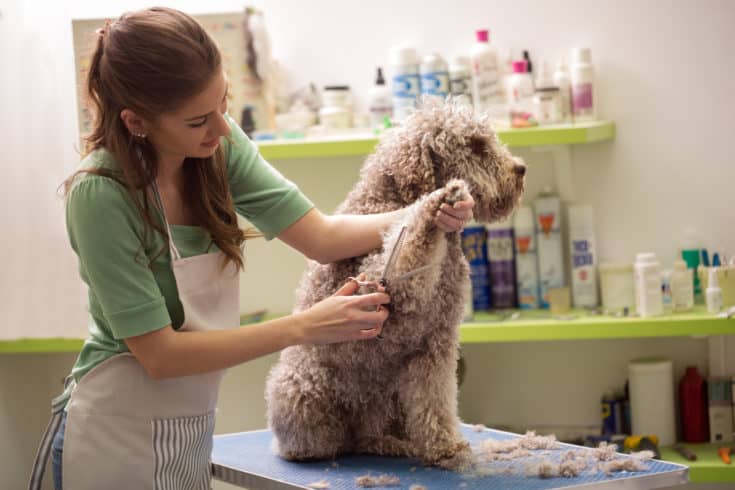
- A groomer not only bathes and trims your dog’s fur, they’ll also:
- Clean their ears and pluck the fur inside the ear canal
- Trim the fur between their paw pads and toes
- Clip and file their nails
- Express their anal glands
- Possibly even brush their teeth!
- Goldendoodle’s usually need professional grooming at least 4 times a year unless you clip them at home, and at the very least will need their nails trimmed and ears plucked every other month
How To Prevent Ear Infections and Spot Them Early!
As floppy-eared dogs, Goldendoodles often develop infections in their warm, moist ear canals. Yeast overgrowth is usually the initial trigger, but bacteria can join the party and cause secondary infections if the yeast isn’t promptly treated.
- Regularly removing the fur in the ear canal (plucking) allows for better air circulation, makes them easier to clean and helps prevent yeast overgrowth, so keep your Goldendoodle’s ears free of fur and debris.
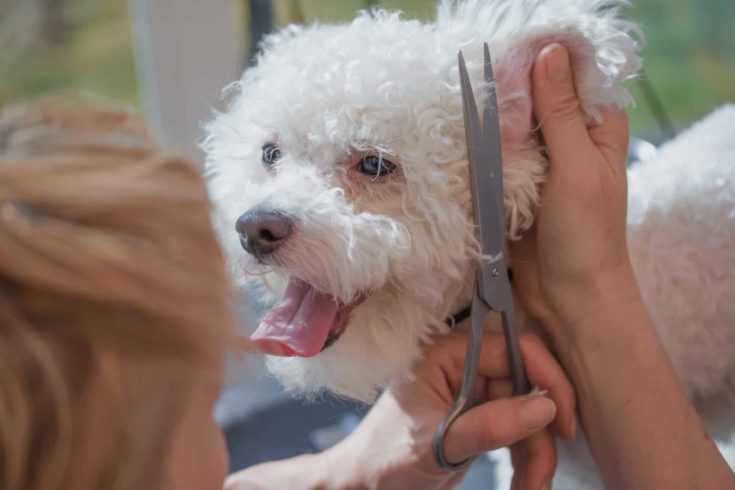
You should make a habit of smelling your dog’s ears a few times a month. Once you’ve learned what their natural odor smells like, you’ll be better able to identify a yeast problem before it blooms into an infection. I know, this sounds gross but it works, and even vet clinics use this technique!
- It’s normal for a dog’s ear to smell slightly like baked bread, but if they smell like fermenting bread dough you’ve got a yeast problem!
- Shaking the head, pawing at the ears or side of the face, or rubbing their face and head on the floor are all early signs of an ear problem in dogs.
- It’s best to clean your doodles ear’s once a week with a gentle ear cleaner like Epi-Otic, or after they’ve gone swimming or had a bath to remove the excess moisture.
At-Home Dental Care
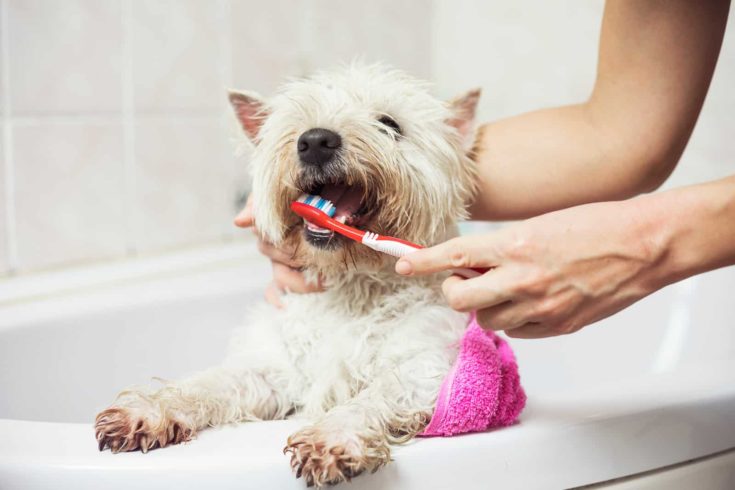
Dental disease can result in more than just expensive extractions; it’s also associated with the development of heart, kidney and liver disease! The best way to reduce your dental bills and keep your Goldendoodle’s mouth healthy is to brush your dog’s teeth every day, or at least 5 times a week:
- Brushing is best, but even most veterinarians don’t do it every day. You can also opt for a water additive or rinse that reduces plaque and tartar build-up (may get expensive for a large dog, though) or use special dental chews or prescription dental diets.
- Giving your doodle hard dog bones, antlers and hooves to chew on is not recommended. These products are not very effective at plaque removal, often cause dental problems like cracked and broken teeth, and can even be hazardous to your dog’s health.
Physical Exercise, Training and Activities for Goldendoodles
While Goldendoodles are a bouncy, high-energy breed, they don’t require intense levels of physical activity to wear them out, which makes them an ideal pet for a busy family. To avoid boredom and the related negative behaviors like destructive chewing, you’ll also need to work them mentally, however:
- Once your puppy reaches adulthood (1 to 2 years), they’re usually satisfied with about 30 minutes of vigorous activity a day and roughly 30 minutes of training and/or games.
- You can expect to spend about an hour a day working with your Goldendoodle to meet their physical and mental needs.
Training and Mental Work-Outs
While basic obedience training is a must for standard Goldendoodles, don’t neglect this training in the smaller mixes, either! Learning to walk on a leash and listen to commands pays dividends down the line. Training should continue into adulthood, since it’s the best way to tire out their active minds and bodies!
- Positive reinforcement and reward-based training programs are ideal for Goldendoodles, since they naturally want to please their owners

- Consider doing Advanced Obedience or getting your doodle certified as a Canine Good Citizen once they’ve mastered the basics.
- For ball-motivated doodles, consider starting them in agility classes, flyball, or even teaching them to dock dive.
- For food motivated dogs, using puzzles and toys with edible rewards is a great way to work their brains and avoid boredom.
Veterinary Care and Health Concerns
To keep your Goldendoodle healthy, they’ll need to see the vet several times as a puppy, and then annually until they’re seniors (around 7 years), when they’ll start needing twice-yearly exams. It’s best to spay or neuter your dog to prevent reproductive problems, and get a microchip placed for emergency identification.
Vaccines for Goldendoodles
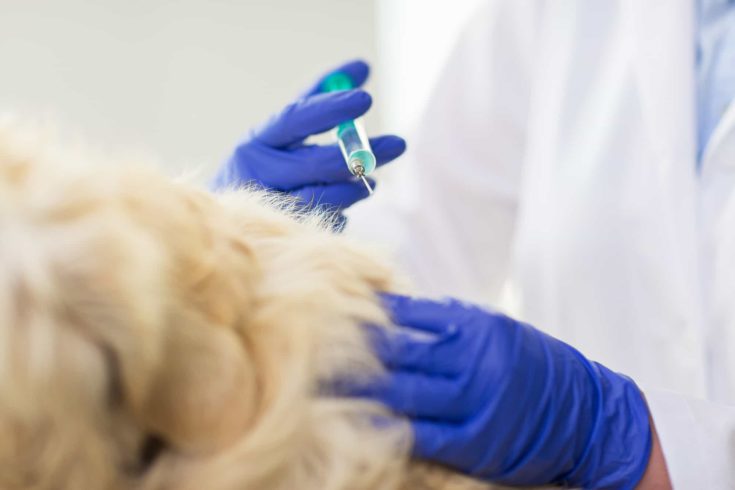
Goldendoodles should get the usual core vaccines against distemper/parvo, canine viruses, kennel cough (bordetella) and rabies (required by law), but you should also talk to your doctor about vaccines for Lyme disease and leptospirosis, a bacterium carried by rodents that can cause acute kidney failure.
Flea and Parasite Prevention
The number one cause of skin problems in dogs is a reaction to fleas, called flea allergy dermatitis. Your vet can prescribe year-round flea control for your doodle, and also consider heartworm and tick preventatives depending on where you live. Fecal exams can catch any internal parasites your dog picks up, too.
Common Hip, Knee and Elbow Problems
Poodles and goldens are prone to issues with their hips, elbows and kneecaps. While they’re not as common in doodles, these orthopedic problems can be triggered by both genetic and environmental factors, so you can’t entirely prevent them. Your Goldendoodle’s parents should be free from any signs of hip or elbow dysplasia (have OFA-certified hips) or luxating patellas (floating kneecaps)
Common Ear and Skin Problems
Goldendoodles have floppy ears, so regular plucking and cleaning will reduce the chances of infections from yeast or bacteria. Environmental allergies are fairly common in their parent breeds and can cause irritated ears, itchy skin and problems with licking, but these seem less common in doodles.
Eye and Vision Issues
It’s common for poodles to develop cataracts, and poodles and goldens carry the genes for Progressive Retinal Atrophy (PRA) and retinal dysplasia, which can cause blindness in young puppies and senior dogs. Your puppy’s parents should have their eyes examined and OFA-certified prior to mating to reduce the chances of passing on PRA.
Heart Health
While they’re less likely to develop the heart condition known as DCM than their parent breeds, doodles still need to be monitored for heart disease. Dental care and routine cleanings can lower the risk considerably, but you may also want to talk to your vet about doing whole-blood taurine testing or adding a taurine supplement.
Other Potential Health Problems: Seizures, Cancer and ACL Injuries
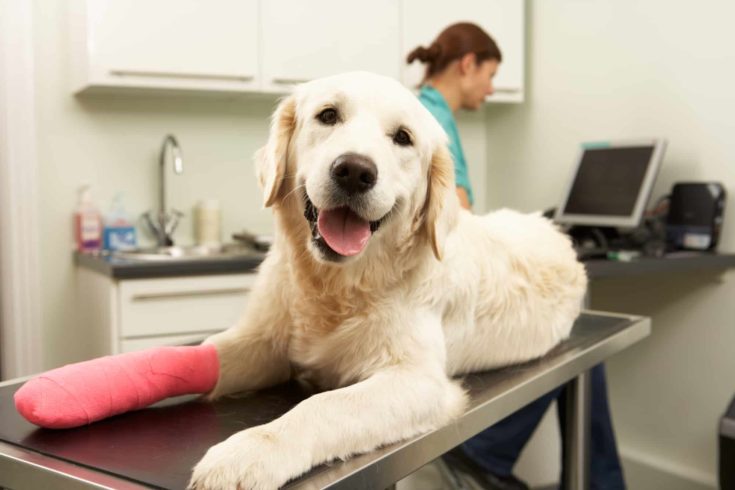
It’s extremely rare, but doodles can inherit a genetic bleeding disorder known as Von Willebrand’s Disease, which reduces their blood’s ability to clot. Most dogs with the condition don’t show any symptoms until a crisis event, or begin to show symptoms as they mature, but luckily it’s not a common problem.
Since Goldendoodles can live for 10 to 15 years on average, there’s other health concerns that may crop up as they mature. These problems include torn knee ligaments (ACL injury), seizures or epilepsy, thyroid problems, lymphoma and cancers like splenic masses and mast-cell tumors.
Standard Goldendoodles Are at Higher Risk of Bloat (GDV)
Due to their size and deep, narrow chest, bigger Goldendoodles are especially predisposed to a medical emergency known as gastric dilatation and volvulus. GDV or bloat, as it’s often called, is when the stomach inverts or twists inside the dog’s abdomen:
- This prevents the gastric gasses from escaping, and leads to a build-up of pressure that can rupture the stomach and cause septic shock
- GDV is a life-threatening emergency, and even with immediate treatment and surgery, many dogs don’t survive
- To prevent GDV, talk to your vet before spaying or neutering your Goldendoodle and ask if they can do an additional procedure called a gastropexy, where the stomach is sutured to the wall of the abdomen to prevent it from rotating and causing GDV. It’s expensive, but worth the cost
Misconceptions About Goldendoodles
Let’s take a second to clear-up a couple of common myths about Goldendoodles that you may come across online or hear directly from a less-than-scrupulous breeder:
Goldendoodles Are Not Hypoallergenic
There’s also no such thing as a hypoallergenic dog, and any dog can potentially trigger an allergy attack in a sensitive person. This myth persists simply because we didn’t know very much about the science of allergies until recently, so it’s tied up in the Goldendoodle’s breed’s history:
- It was once thought that pet hair was the primary cause of allergy symptoms in people, so doctors recommended short-haired, low shedding or hairless breeds for allergy sufferers.
- We now know that allergies are triggered by multiple proteins found in the dog’s saliva, skin, dander, hair, and even their urine!
- Low-shedding Goldendoodles may cause fewer problems for some allergy sufferers, but managing symptoms may still be tricky even with medications, extra brushing and baths, and it doesn’t always work out for those with severe dog allergies.
Goldendoodles Are a Hybrid Breed, But They’re Not Necessarily Healthier
Another common fallacy about doodles is that they have fewer health problems and a longer lifespan because they’re a hybrid breed, a concept known as “hybrid vigor.” As a vet tech, I’ve seen too many who relied on the healthy mix breed myth and were shocked when their “hybrid doodle” inherited a common problem:
- Poodles and goldens have been around since the 17th and 18th centuries, so they have less genetic diversity than many breeds. This increases the chances that their offspring, even mixed breeds, will inherit problem genes.
- While some first-generation Goldendoodles may have fewer problems than a typical golden or poodle, it depends on the quality of the parent stock. Mixed breed dogs are not automatically healthier or longer-lived.
- While some first-generation Goldendoodles may have fewer problems than a typical golden or poodle, it depends on the quality of the parent stock. Mixed breed dogs are not automatically healthier or longer-lived.
- Hybrid animals may sometimes experience faster growth rates or higher fertility than their parents, but not always, and the benefits usually fade past the first generation. Multigen Goldendoodles are no more likely to be healthy than their purebred poodle and golden ancestors.
Breeding Healthy Goldendoodles and Finding a Good Breeder
There’s a lot more to breeding dogs than just putting an intact male with a receptive female, so you should carefully consider every aspect and do a lot of research before breeding your Goldendoodle. The best way to start is by connecting up with an experienced local breeder and arranging for an apprenticeship with them.
- The most important thing to know is that Goldendoodle breeding is not a profitable hobby, and if you do things right you’ll spend more to produce each litter than you’ll earn from selling the puppies.
How to Find a Responsible Breeder
To ensure the parents are healthy, and to reduce the chances of passing on genetic predispositions, responsible Goldendoodle breeders do a lot of health and genetic tests before they arrange any matings. This is why mixed breed puppies can cost as much or more than a purebred poodle or golden!
Responsible Goldendoodle breeders:
Keep all their animals up-to-date on exams and vaccines, flea and heartworm control, grooming and dental care.
Don’t breed their dog’s until they’re fully mature (2 years), and retire their female’s after 2 or 3 litters of puppies.
Screen the parents for problems with their hips, eyes and heart before mating, including OFA-certifications for the eyes and hips and a cardiac exam and echocardiogram to screen for heart disease.
Also screen the parents for sexually transmitted diseases like brucellosis, and may do further genetic or health testing as well.
Adopting a Goldendoodle
Puppy placements don’t always work out, and Goldendoodles often end up in humane societies, shelters and rescues around the country. If you’d like to adopt a Goldendoodle, check out your local poodle and golden rescues, since they often take mixed breeds too, or look to national organizations like:
Goldendoodles: Product and Supply List
Here’s a shopping list of the basic and supplies you’ll need for your Goldendoodle! Obviously, there’s a limitless number of toys, beds and fancy collars you could get, so it’s by no means a definitive or exhaustive list.
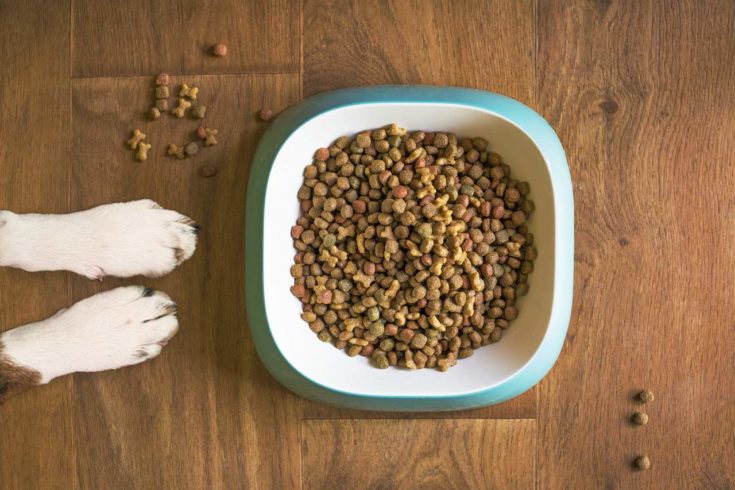
- High-quality commercial dog food and treats
- Appropriate size kennel or crate, with pads and bedding
- Food and water bowls
- Variety of safe toys for chewing and play
- Leashes and a collar for their ID tag and rabies license
- Brushes, a flea comb and nail trimmers
- Ear cleaner and cotton balls
- Dental supplies, including a toothbrush and toothpaste
- Additional dog bed or blankets for the family room
- Flea/heartworm/parasite preventatives
Conclusion
If you’re considering a Goldendoodle as a family pet, you’re in good company! The demand for doodles has never been higher, and breeders around the world are working to solidify them as a legitimate and recognized breed. There’s really nothing cuter than a Goldendoodle puppy, and we’d love to hear about your doodle in the comments below!
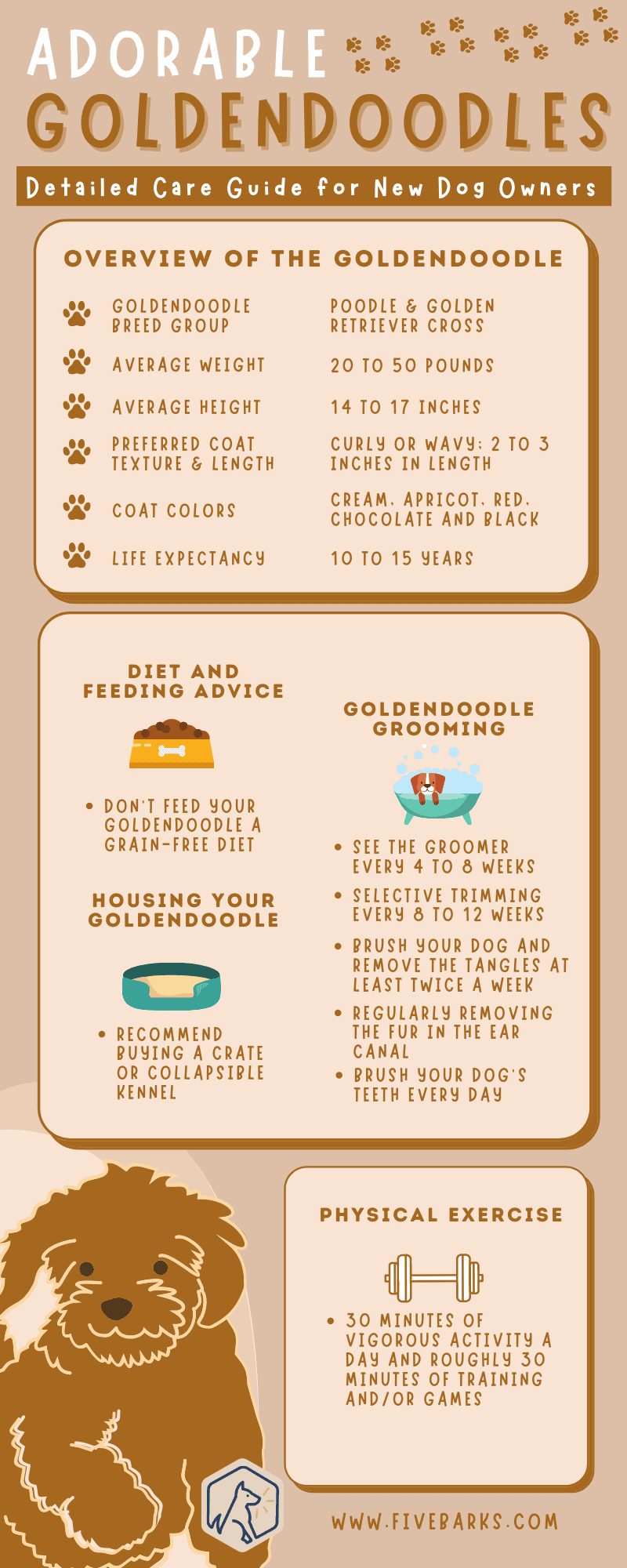
1 ตอน
